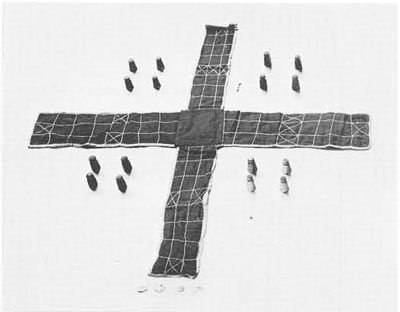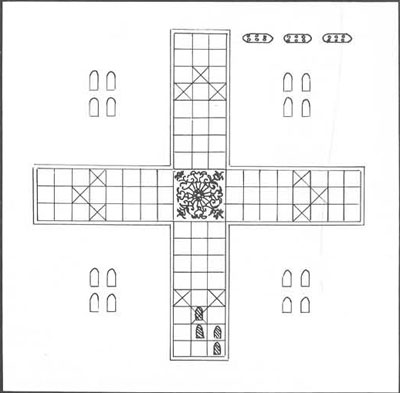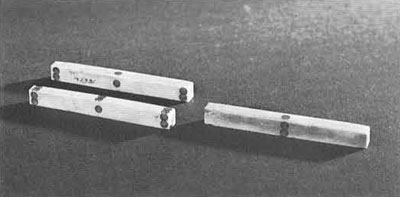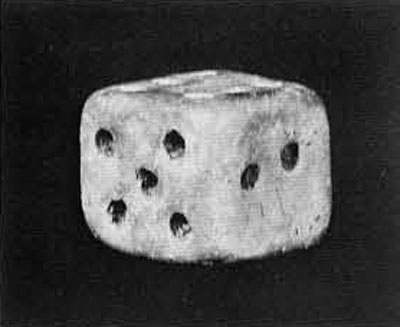The Museum of the University of Pennsylvania owns several “boards”–they are actually made of cloth–used for playing the games known in India as pachisi (pacisi), chaupar (caupara), and chausar (causara). One of these is illustrated here. In the United States and elsewhere in the Western world a modified version of these Indian games, variously called pacheesi, pachisi, parcheesi, chessindia, or the like, has been known for almost a century and enjoys considerable popularity, especially with children. The Indian games also exist in regions adjacent to the Indian subcontinent.

The first description of any of these games seems to have been written in the 16th century, when chaupar was a common gambling sport at the court of the Mughal emperor Akbar in Agra and Fatehpur Sikri. The emperor himself was an addict and in the courtyard of his palace at Fatehpur Sikri he had laid out in flagstones a huge “board” where he and his courtiers enjoyed the game, using slaves as the playing pieces. How much older than Akbar the game is, it is not possible to say, but Abul Fazl, vizier and historian of Akbar, remarks of chaupar, “From times of old, the people of Hindustan have been fond of this game,” but adds no further information about dating. Some of the features and paraphernalia of the games, though not the games themselves or the board, seem to have existed in India as long ago as the latter part of the third millennium B.C.
Because of the wide provenience of the games, their age, and their anthropological interest, they have had some study by scholars both ancient and modern. One of the better descriptions of the “boards” and the method of playing the game is given by Stewart Culin in his work “Chess and Playing Cards” in the Report of the U.S. National Museum for 1896. Mr. Culin had been a curator in the “Museum of Science and Art” (now the University Museum) of the University of Pennsylvania in 1889 and was Director of the Museum from 1892 to 1903.
Chaupar or Chausar
The first of these games to be described in ancient Indian sources is chaupar or chausar. The same Abul Fazl mentioned above describes how the game is played with sixteen pieces, three dice, and a “board” in the shape of a cross. Various rules and orders of play are included in the description.
Other references or descriptions of the game of chaupar appear in the 19th and 20th century, but the most important description next to Abul Fazl’s is one by Richard Carnac Temple, one of the most eminent authorities on Indian folklore who has ever lived. He collected a number of legends in Punjabi and published them with translations (The Legends of the Punjab, Bombay, 1884-1900), commenting at one point upon chaupar and pachisi. In his exposition on chaupar he devotes considerable attention to a description of the technicalities of the game, including the Indian names for the various throws of the dice.
Certain distinguishing features of the game come out clearly in the descriptions of Abul Fazl and Temple. Especially interesting is the fact that it is played with long dice (tabular or stick dice), which are common in South and Southeast Asia, not with cubical dice such as are familiar to Americans and Europeans. Three such long dice were used in the play.

The derivation of the names chaupar (caupara) and chausar (causara) seems to be as follows. The Hindi caupara is a compound of cau (from Sanskrit catur) “four” and para (from Sanskrit pata) “cloth”, the latter referring to the cloths (“board, table”) which form the four arms of the playing surface. The whole word means “that which is composed of four boards.” The Hindi causara is also a compound, of which the first element is again cau (from Sanskrit catur) “four,” while the second, which is sara, is the Sanskrit sara meaning “act of going, means of going, way, road.” The whole compound, therefore, seems to mean “that which consists of four roads, a corssroad” and to refer to the crossroad-like form of the board.
Pachisi
The game of pachisi might be called the poor man’s chaupar. Instead of being played with stick dice, it is played with cowries (Hindi kaurii), a small shell which as late as the first part of the 20th century was used by very poor people for money. The use was unofficial, not being authorized by the government as currency of the realm, and the value fluctuated. Fifty or sixty might be worth a copper pais, which before World War II was equivalent to about half of an American cent. Temple also gives a description of this game that points out the differences in play between it and chaupar.
The number of cowries used in the game may be five, six, or seven. The value of the throw is determined by the number of “mouths” or clefts which are up. When only five cowries are used, the highest throw is that with all five “mouths” up, which is valued at twenty-five. This is responsible for the name of the game. The Hindi word for “twenty-five” is pachis (pacis), from which is derived the noun pachisi (pacisi) meaning “collection of twenty-five objects” or “that which concerns or has a relation to twenty-five.” This point might argue that the earliest form of pachisi used only five cowries.
While the chaupar and chausar as names of games are taken from the board on which the games are played, as baseball is named from the four bases that are the most characteristic feature of the field on which that game is played, pachisi is named from the high value of a throw, much as the game of twenty-one is named from the object of the game, which is to get cards whose face values total up to twenty-one.
If we look at the equipment used in playing chaupar and pachisi we find that not only the men, but also the oblong dice for chaupar and the cowries for pachisi are as old as the third millennium B.C., while the four-armed cruciform board appears to be a development from much simpler gaming boards, marked in squares or houses, of the same period.
The use of both cubical and oblong dice was evidently common in the Indus Valley (Harappan) sites of about 2300 B.C., with the oblong dice being somewhat the commoner. These latter were generally rectangular in section, occasionally triangular, and variously marked with numbers. For example, all the sides might be different, or two sides might be similarly marked. Cubical dice are known in antiquity outside of India (for example at Ur and Tepe Gawra in Mesopotamia and Tell el’Amarna in Egypt), but oblong dice occur very rarely, if at all, outside that country in this early period.
Though the Harappan sites of the third millennium B.C. give us our earliest material evidence of civilization in India, we have no literary texts from that period, and we cannot even read the brief messages written on the many seals that have been recovered from that time. We do not know the language, and we cannot say how the Indus Vally people used their dice.
When we get our first literary texts in India, we find that dice-playing was a common failing of the upper classes. The Rig-Veda, which we may reasonably consider to have been in its present form before 1000 B.C., has references to the use of dice, and one of its hymns (Book 10, 34) is a charm to cure an inveterate and unsuccessful gambler of the compulsion to gamble that has ruined him. In the Atharva Veda, also, gambling with dice is mentioned (2.3; 4.38; 6.118; 7.52; 7.109). The Aryans of Rig-Vedic times made their dice of the vibhidaka-tree nuts, and we do not know how they used them.

Museum Object Number(s): 18612A / 18612B / 18612C
Evidently dicing was considered a fitting vice of kings, and in the ritualistic literature of the centuries following the Rig-Veda, say at around 800 B.C., the consecration ceremonies for a king included a game of dice–which the new king must always win–and there was a special officer to take charge of the dice.
In the great epic known as the Mahabharata there are two famous instances of kings ruined by gambling. These legends were of perhaps the fourth century B.C., and allusions in them show that dicing was no longer regarded merely as a matter of chance or even of control by superhuman beings, but was a science. The man who knew how to throw the dice was a sure winner.
Dice in general in Sanskrit are known as aksa; the oblong dice are distinguished with the name of pasa, pasa, pasaka, parsa–all being variants of one another and connected with the Hindi pasa and the Punjabi phansa. A form of the word occurs in the Buddhist story-collection known as the Jataka-book, which has some material dating from before the beginning of the Christian era and the rest from the first few centuries following. There is a story of a king who was so skilled in the science of dicing that when his opponent threw these oblong dice in the air, he could tell before the struck the dicing-board whether or not the throw would be favorable, and if it would be to his disadvantage he would catch the dice before they landed and have his opponent repeat the throw. The various throws were named, with names that would not be comprehensible from the story text, but we have another work that lets us know what they were.
This other text was a manual for reading the significance of dice throws for divination, not gambling, but it has the same terms. The oblong dice to which the throws refer were marked on their sides 1, 2, 3, 4. Since there were three dice used, and these three dice had a fixed order, a total of sixty-four combinations was possible. In the text, called the Pasaka-kevali, known in one recension as early as the fourth century A.D., these throws are indicated by name, and their prognostications are given.
The marking on the modern oblong dice is not always the same as that one the dice covered by the Pasaka-kevali. The game of chaupar uses marks of 1, 2, 6, 5, (sometimes 1, 3, 4, 6). We have already noticed that in the Indus Valley, nearly 4500 years ago the oblong dice were not uniform in their marking. The custom of having a fixed order for the three dice seems not to prevail in the playing of the games; hence only twenty combinations are possible, as against the sixty-four in the other case.
The cowries, which are used in pachisi, are also as old in India as the Harappa civilization of the third millennium B.C. But we cannot say at all that they were used at that time either as money, as they are at present, or for gambling. We do know that by the 8th century B.C., or possibly later, gold cowries were used in the royal consecration ceremony mentioned above in place of dice. The number of cowries was five, and this number seems to be the standard even to the 14th century A.D., when a learned commentator on this ceremony states that when all five cowries fall alike, that throw always wins. In modern times, pachisi is played with 5, 6, or 7 cowries, but the highest throw is generally that when five cowries fall alike, with the opening up, and it is this throw, counting twenty-five, which later gives the game the name of pachisi, as we have seen above.

Museum Object Number(s): 31-52-309
Unlike the pieces, dice, and cowries, the form of the board seems relatively modern. It does not seem to exist in any earlier specimen than those set in palace courtyards by the Emperor Akbar in the second part of the 16th century, about four hundred years ago. However, there are simpler forms of gaming-boards found in early archaeological sites, which are presumably prototypes of the boards used for the three games we are considering. At Mohenjo-daro in the Indus Valley, a portion of a triple-rowed gaming-diagram on brick was recovered, dating perhaps from the last part of the third millennium B.C. Boards are frequently mentioned in early texts dealing with gambling, although they are not described; and sometimes square ones are shown in sculpture. Square boards, used for chess or similar games, are known in ancient India and the Sanskrit language has a word for them, astapada, meaning “having eight legs,” in reference to the eight rows of squares. But there is no Sanskrit word to describe the board used for chaupar and pachisi.
“Pachisi” in America
A variation of the Indian games was introduced commercially into the United States in the 1860’s by a certain John Hamilton, living in the Hudson River Valley. He first marketed his adaptation under the name “Patcheesi” and filed a claim for a copyright in 1867 (the present legal distinction between “copyright” and “trademark” does not seem to have been drawn clearly at that time). Mr. Hamilton evidently expected the name to be pronounced like the Hindi pachisi (pacisi). He presumably obtained the name from someone who represented the sound of the second consonant by “tch” (as in “patch”) rather than by “ch” (as in “church”). But the game was still very young when Mr. Hamilton discovered that people were pronouncing it “potcheesy” as though it had something to do with “pot cheese,” which is a dialectic name for cottage cheese. He sought a way to obviate this indignity and, apparently not thinking that it would be enough just to delete the “t,” looked instead for a substitute. He ended up with “r,” and in 1869 adopted the name “Parcheesi,” characterized in due time by the Oxford English Dictionary as “erron.” His game used two cubical dice rather than three long dice or a number of cowries, and some of the playing rules differed from those for chaupar/chausar and pachisi, but the board is essentially the same, with the same number of squares or boxes and with castles (“Safety Points” in the American terminology) in the same places.
Just as diagrams of the pachisi board may be found all over India–in Akbar’s palaces and Rajasthani and Pahari miniature paintings, or cut by a later hand in the stone floor of a Pallava tample at Conjeevaram, and traced in the dust of streets or on the flagging of station platforms, so is that same board, whether as Parcheesi or under some other name, a bit of standart equipment in American homes with children aged eight or thereabouts. It is John Hamilton’s contribution to American social history.
